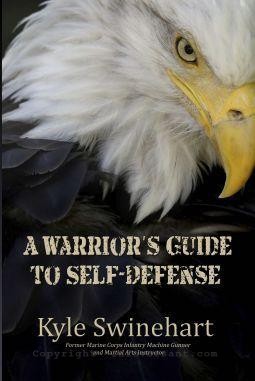Self-Defense. Anyone can come under attack at any time. If you travel alone at night in high crime rate areas, it is obvious that there is a higher chance that you will get mugged or attacked.
As I see it, there are mainly two aspects to self-defense. One is the physical ability, the strength. The other, more important part, is the mental make-up you need to fight and readiness to hurt the opponent. All our non-violence conditioning acts against the need to defend ourselves during an attack.
Most of us are taught all our life not to pick a fight or be violent. We are taught that violence is not the answer. But what do you do when you are not the aggressor? What if you see an imminent threat. If you do not have a mind-set for violence, it is quite probable that you will freeze.
In A Warrior’s Guide to Self Defense, Kyle Swinehart discusses the mindset you need to adopt when you are forced to defend yourself and be violent as well as the physical techniques that will help you to get out of the threatening situation.
Kyle Swinehart is a former Marine Corr infantry machine gunner and has seen combat in Afghanistan. The objective of this book is to give untrained people a framework that will help them counter an attack and come out alive from the confrontation.
 A Warrior’s Guide to Self-Defense
A Warrior’s Guide to Self-Defense
Author: Kyle Swinehart
Pages: 94
Publisher: First Edition Design Publishing (April 20, 2015)
ISBN-10: 1622878981, 978-1622878987
There is, of course, much more to self-defense than just the desire to defend. Realization of threat can trigger various body functions which you can use to your advantage, but they can just as easily put you at a disadvantage. The author shows you how you can stay calm and prepare for the attack in the short time. How you can stay focused during the attack and inflict maximum damage in a short time.
While this book will not train you as a fighter and will not prepare you against a trained fighter, it gives you enough tips and tricks for you to get out of the situation and find cover.
The author discusses various physical areas that can help you incapacitate your opponent. He also talks about the best methods to attack your opponent. For example, punching someone might seem the obvious response. However, the author informs the reader that this action could easily injure your fist and that hitting someone with a hammer-like blow using the base of the palm is a much safer and better option.
Similarly, the book also discusses how to handle a more powerful and bigger attacker and the body postures that will help you generate maximum force.
It is nearly impossible to predict how you will react to an attacker. But when your your life is at stake, there is no option but to fight back. Reading, knowing, and practicing the various maneuvers and stances in the book will give you the information that you need in that split second when your mind is desperately trying to defend your body and planning your next move.
Fight or Flight, whatever you decide, the information in A Warrior’s Guide to Self-Defense will better prepare you to execute your plan.